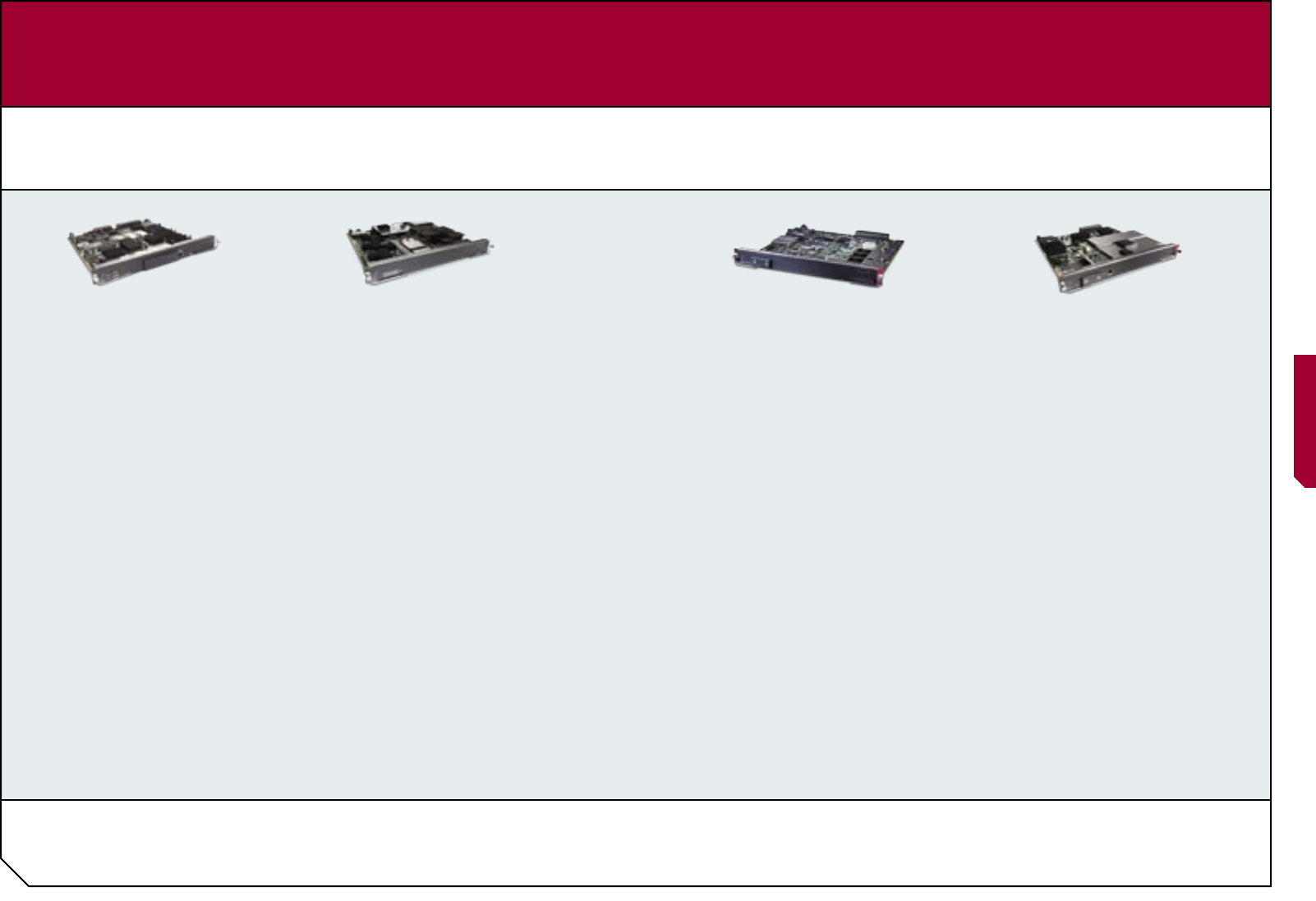
42
Cisco Service Modules continued
Content Switching Module with SSL
This module combines advanced Layer 4–7 content
switching capabilities with Secure Sockets Layer
acceleration, freeing backend servers from the
CPU-intensive task of processing SSL transactions.
• High-speed content switching provides load balancing,
increases performance, ensures connection persistence,
and helps maximize uptime for application and Web
servers, caches, firewalls, and other devices.
• End-to-end encryption with intelligent load balancing
ensures information on the network never appears as
clear text.
• Reduces the number of SSL devices needed and
reduces the number of certificates that a site requires
to purchase and manage, lowering both capital and
operating expenses.
• Combines content switching and SSL acceleration
in a single chassis slot, freeing up space for other
integrated services.
Content Switching Module
This module adds advanced, high-performance Layer
4–7 content switching and load balancing to existing
Layer 2 and 3 features of the Catalyst 6500 switches,
reducing application response times, optimizing service
delivery, increasing application time, and increasing
service scalability for servers, firewalls, VPN devices,
SSL termination devices, and caches.
• Supports a wide range of common IP protocols,
including TCP, User Datagram Protocol (UDP),
and higher-level protocols, including Hypertext Transfer
Protocol (HTTP), File Transfer Protocol (FTP), Telnet,
Domain Name System (DNS), Real-Time Streaming
Protocol (RTSP), and Simple Mail Transfer Protocol
(SMTP).
• Reduces the cost and complexity of deploying content
switching services by allowing for integration into
existing infrastructure.
• Fault-tolerant configurations to provide improved
application uptime, utilizing both connection and sticky
state redundancy for seamless failover.
• Ability to integrate content switching services into an
existing infrastructure minimizes the time and resources
required for deployment.
• High-density, scalable platform with proven reliability
offers unparalleled investment protection.
Applications Control Engine Module
This module is Cisco’s next-generation application
delivery solution, providing the industry’s highest
throughput (up to 16 Gigabits per second), rich multi-layer
security, and unique virtual partitioning capabilities.
The ACE multi-service module offers many new
capabilities, including hundreds of virtual partitions,
per-partition resource allocation, role-based access
control, and a XML management API.
• Partitions network into up to 250 logical devices that
can be managed and operated separately. Role-based
access control capabilities enable IT to delegate
management tasks to distributed IT teams, guarantee
resource levels for each logical partition, and apply
desired functions to each partition separately.
• Allows IT to control the infrastructure centrally while
delegating application administration to separate
operational teams. Also simplifies application
infrastructures, shortens the workflow necessary to
bring applications and business services online,
and shortens time-to-deployment of applications.
• Also consolidates functionality such as server load
balancing and off-load application acceleration,
and application-layer security.
• Supports 4, 8, or 16Gbps of data throughput and up
to 345,000 sustained connection setups per second.
Several ACE modules can be deployed in a Catalyst
6500 Series chassis for even higher throughput.
Applications-oriented Networking Module
This module provides an essential point of convergence
between today’s intelligent networks and applications
based on highly distributed, service-oriented, and
traditional architectures. It embeds a new class of
application intelligence into the network to better meet
the underlying needs of applications for real-time visibility,
security, event-driven messaging, optimized delivery,
and other core integration and deployment services.
• State-of-the-art design incorporates hardware and
software components pre-integrated into a complete
subsystem that can be flexibly deployed in enterprise
data centers, service provider networks, or other
scenarios as an embedded network function.
• Includes software tools for managing and provisioning
Cisco AON nodes, as well as for designing application
policies using a library of “bladelets” that can be
configured in different sequences as required.
• Also includes a software development kit and API for
flexible extension to any custom environment, operation,
or format.
• Provides operational consistency and reduces total cost
of ownership by consolidating elements of network and
application infrastructures and providing centralized
management capabilities.


















